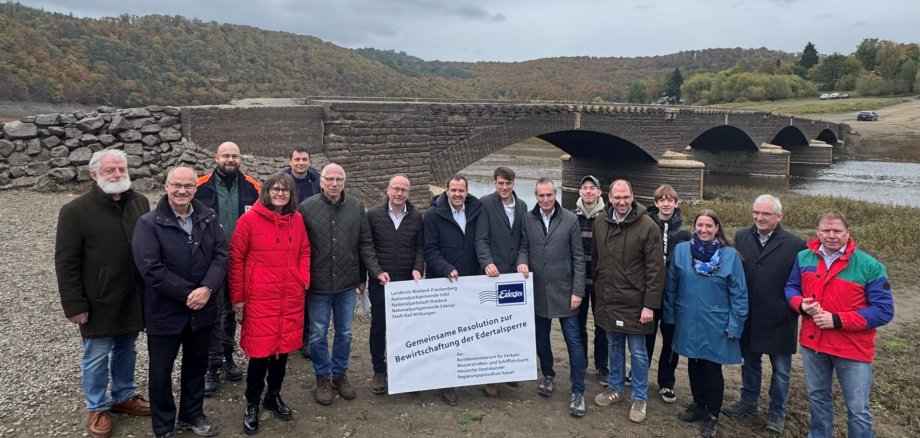Lake Edersee: District and municipalities are in favour of a change in management
Together with the town of Waldeck, the municipality of Edertal, the town of Bad Wildungen and the municipality of Vöhl, the district of Waldeck-Frankenberg is campaigning for the further development of water management at Lake Edersee. Resolutions to this effect with identical messages were recently passed in the local parliaments. The aim is to manage the water level in a way that takes into account the requirements of shipping on the Weser as well as nature conservation and tourism on Lake Edersee.
Water level as low as rarely seen
A dried-up lake bed, empty jetties and the emerged ruins of the Edersee Atlantis: the picture is similar every summer - sometimes earlier, sometimes later. This year, however, the water level is extremely low. This has prompted local politicians in Waldeck-Frankenberg to once again call on those responsible at state and federal level to adapt the concept for controlling the water level. In their resolution, they plead for equal living conditions, a balanced consideration of interests and a more precise and climate-dependent control technology that takes quality of life, ecology and nature conservation into account.
Demand for a permanently appropriate water level in the dam
"Every summer, we see an empty Edersee. This is a problem - not only for tourism and gastronomy at the lake, but also for ecology, nature conservation and our regional economy," emphasises District Administrator Jürgen van der Horst. "We are therefore calling on the state and federal government to weigh up interests in a balanced way in order to ensure a permanently appropriate water level in the dam - as a basis for basic services, living and working in the region," explains Karl-Friedrich Frese, First District Councillor of the district. For this reason, the district council not only approved a corresponding resolution by the district committee, but also a thematically appropriate resolution motion by the FDP, Free Voters and Bündnis90/DIE GRÜNEN parliamentary groups.
Outdated operating regulations
The municipalities want to create equal living conditions, open up opportunities for the development of the region and achieve a balanced consideration of interests. "The operating regulations for the Eder dam are outdated and one-sidedly favour the interests of shipping on the Upper Weser. Compromises that have been reached in the meantime regarding management have even been abandoned in favour of the Edersee," complains Nicolas Havel, mayor of the national park town of Waldeck. The local authorities along the Weser could also benefit from the demands - they may take them up in their own resolutions.
Expansion of winter water-saving operation
"We need a water level control system that takes weather and climate data into account and not an event-driven, but a long-term controlled water release," adds Frederik Westmeier, mayor of the Edertal National Park community. Furthermore, the winter-saving operation - i.e. reduced water release from November to February - must be extended to include the month of March in order to ensure that the dam is completely filled by the end of May each year.
Adaptation of the flood protection volume
"It is important to find solutions together that benefit everyone," continues Karsten Kalhöfer, mayor of the national park municipality of Vöhl. "The earlier trigger line model was a good example of how interests can be harmonised. The longer the water remains in the Edersee, the longer the Weser can be supplied. The situational adjustment of the flood protection volume is another issue. This is precisely the kind of approach we should be developing further, not abandoning." Lake Edersee is used for flood protection in order to act as a retention area in the event of heavy rainfall or thaw. The joint resolution by the district and local authorities calls for the flood protection volume to be adjusted from 10 million cubic metres to five million. This would make it possible to respond to climatic changes and adapt flood protection to the situation.
Deterioration of fauna and flora on the banks
Last but not least, Lake Edersee as an ecosystem also provides a habitat for numerous animals and plants. "Although a rapid and strong release of water from the Eder dam serves to protect the aquatic habitats on the lower Eder and Upper Weser, it leads to a deterioration of fauna and flora in the shore areas of Lake Eder," continues Hartmut Otto, First Councillor of the town of Bad Wildungen. "We need to take the Kellerwald-Edersee National Park, the Natura 2000 sites and the EU Water Framework Directive into account here."
The representatives of the district, towns and municipalities are therefore working together to bring about a rethink - towards a more contemporary management of the Edersee dam and equal consideration of the various interests.
Background
The Eder dam was put into operation in 1914, has been used for flood protection ever since and still secures the water supply of the Upper Weser today. With a capacity of almost 200 million cubic metres, the Edersee is the third largest reservoir in Germany. The management of the Eder dam has been the subject of public debate for decades. Time and again, this has centred on balancing the interests between the water level, which is important for shipping on the Upper Weser and must be guaranteed all year round, and the interests of tourism, gastronomy, the economy, ecology and nature conservation on Lake Edersee.
Caption: The district and the towns of Waldeck and Bad Wildungen as well as the municipalities of Edertal and Vöhl have jointly adopted identical resolutions in favour of further developing the water management of Lake Edersee and handed them over to representatives of the Waterways and Shipping Authority. Representatives from politics, tourism, the state of Hesse and the Kassel Regional Council were also present at the meeting. The event took place at the Old Asel Bridge, which is normally many metres under water. (Photo: District of Waldeck-Frankenberg)
